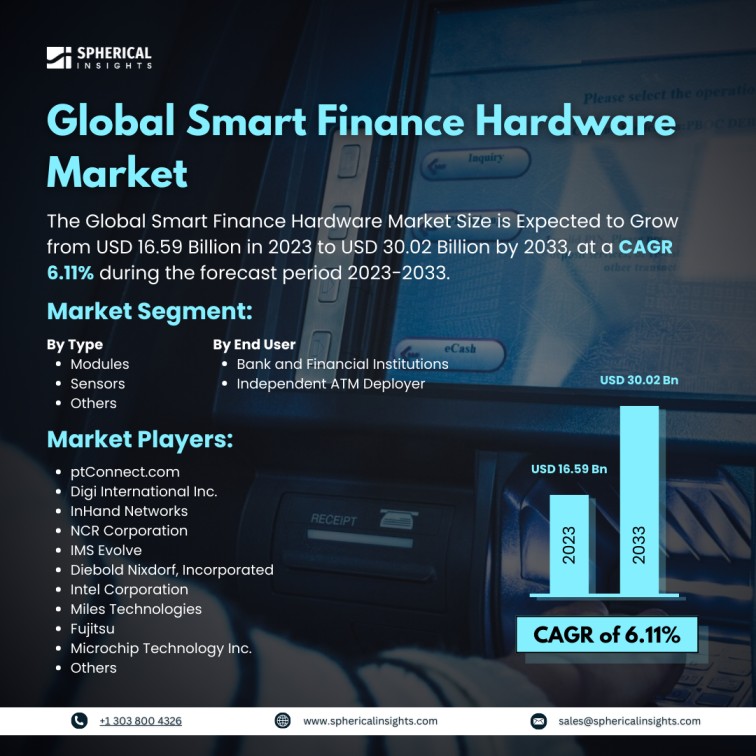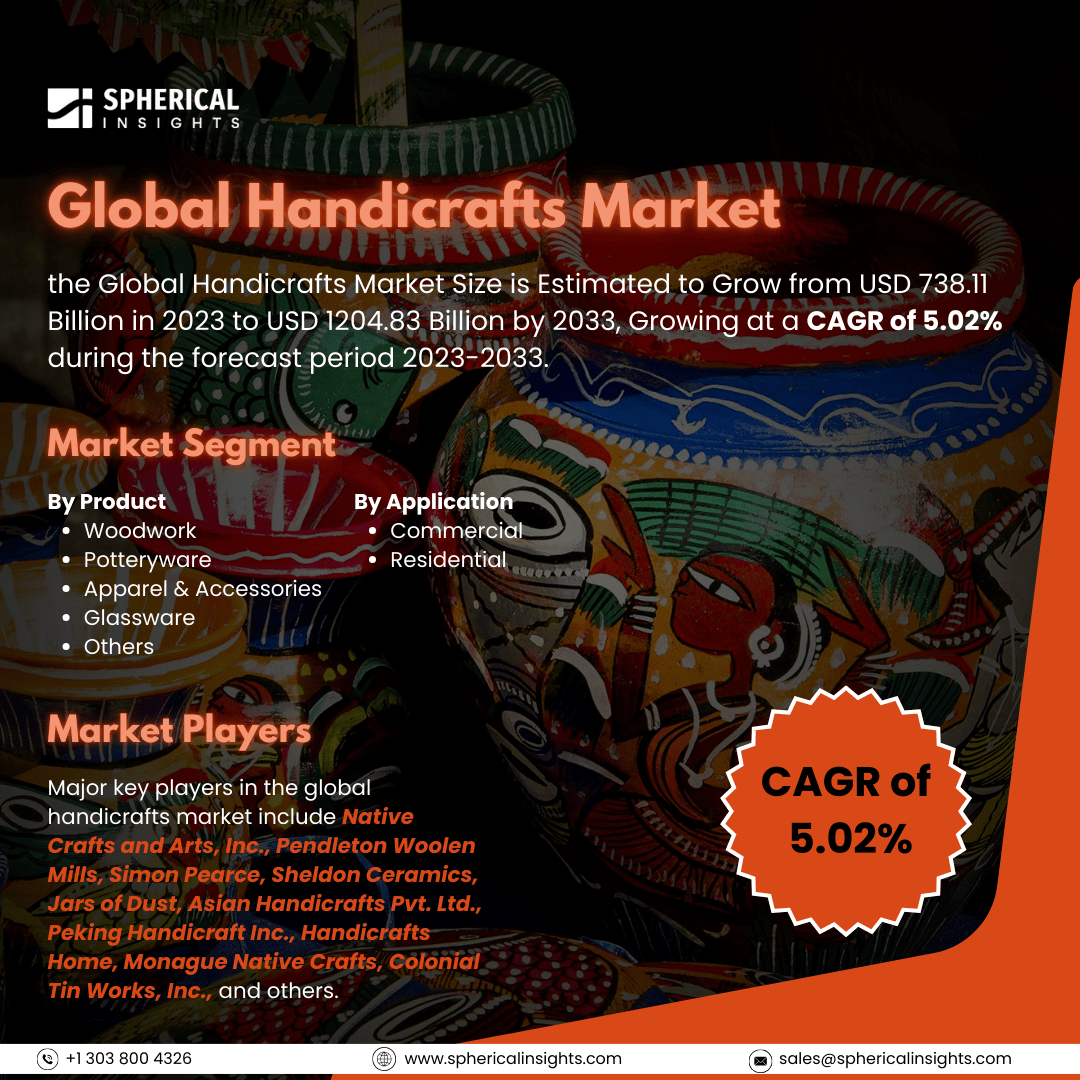Global Smart Finance Hardware Market Size to worth USD 30.02 Billion by 2033
According to a research report published by Spherical Insights & Consulting, the Global Smart Finance Hardware Market Size is Expected to Grow from USD 16.59 Billion in 2023 to USD 30.02 Billion by 2033, at a CAGR 6.11% during the forecast period 2023-2033.
Browse key industry insights spread across 210 pages with 110 Market data tables and figures & charts from the report on the Global Smart Finance Hardware Market Size, Share, and COVID-19 Impact Analysis, By Type (Modules, Sensors, and Others), By End User (Bank and Financial Institutions, Independent ATM Deployer), and By Region (North America, Europe, Asia-Pacific, Latin America, Middle East, and Africa), Analysis and Forecast 2023 – 2033.
The smart finance hardware market refers to the sector that encompasses physical devices and equipment designed to enhance the financial industry through advanced technology. These devices are utilized for various purposes, such as payment processing, data collection, and customer identification. The growth of the smart finance hardware market is primarily driven by several factors: the increasing adoption of contactless payment methods, the rising demand for secure and convenient financial transactions, the growing integration of Internet of Things (IoT) technology in ATMs, the need for improved customer experiences, and ongoing advancements in biometric identification systems. All of these elements contribute to the demand for sophisticated hardware solutions within the banking and financial services sector. However, there are several major challenges facing the smart finance hardware market. These include high initial investment costs, concerns about data security and privacy, a lack of widespread adoption in certain regions, the potential for technical issues, regulatory complexities, and the need for significant upgrades to existing infrastructure in order to integrate smart finance hardware into current financial systems.
The modules segment is predicted to hold the largest market share through the forecast period.
Based on the type, the smart finance hardware market is classified into modules, sensors, and others. Among these, the modules segment is predicted to hold the largest market share through the forecast period. This is attributed to the rising need for modular and adaptable financial solutions. These modules enable financial institutions to improve their services by seamlessly incorporating cutting-edge technologies, resulting in greater operational efficiency and enhanced customer satisfaction. As companies increasingly look to implement innovative financial solutions, the flexibility and scalability of module-based systems give them a competitive advantage in the marketplace.
The independent ATM deployer segment is anticipated to hold the highest market share during the projected timeframe.
Based on the end user, the smart finance hardware market is divided into bank and financial institutions, independent ATM deployer. Among these, the independent ATM deployer segment is anticipated to hold the highest market share during the projected timeframe. This is driven by an increased focus on cash accessibility and consumer convenience. Independent ATM deployers offer customized services that cater to particular regional and demographic requirements, often addressing gaps left by conventional banks. Their capability to provide strategic locations and attractive transaction fees boosts their attractiveness, establishing them as significant contributors to the financial ecosystem.
North America is estimated to hold the largest share of the smart finance hardware market over the forecast period.
North America is estimated to hold the largest share of the smart finance hardware market over the forecast period. This is largely due to the region's sophisticated technological infrastructure and the high uptake of innovative financial solutions. The presence of several prominent financial institutions and fintech firms cultivates a competitive landscape that encourages ongoing investment in smart hardware. Moreover, consumer demand for seamless and efficient banking experiences further drives the need for smart financial hardware in this area.
Europe is expected to grow the fastest during the forecast period, driven by a blend of regulatory endorsement for digital financial solutions and a strong initiative towards cashless transactions. As consumers in Europe increasingly adopt digital banking and payment methods, there is a parallel increase in the demand for innovative financial hardware. Additionally, the region's significant emphasis on sustainability and security in financial transactions is spurring investments in advanced technologies, positioning Europe as a vibrant market for expansion.
Competitive Analysis
Major key players in the smart finance hardware market includes ptConnect.com, Digi International Inc., InHand Networks, NCR Corporation, IMS Evolve, Diebold Nixdorf, Incorporated, Intel Corporation, Miles Technologies, Fujitsu, Microchip Technology Inc., and others.
Key Target Audience
- Market Players
- Investors
- End-users
- Government Authorities
- Consulting And Research Firm
- Venture capitalists
- Value-Added Resellers (VARs)
Market Segment
This study forecasts revenue at global, regional, and country levels from 2023 to 2033. Spherical Insights has segmented the smart finance hardware market based on the below-mentioned segments:
Global Smart Finance Hardware Market, By Type
Global Smart Finance Hardware Market, By End User
- Bank and Financial Institutions
- Independent ATM Deployer
Global Smart Finance Hardware Market, By Regional Analysis
- North America
- Europe
- Germany
- UK
- France
- Italy
- Spain
- Russia
- Rest of Europe
- Asia Pacific
- China
- Japan
- India
- South Korea
- Australia
- Rest of Asia Pacific
- South America
- Brazil
- Argentina
- Rest of South America
- Middle East & Africa
- UAE
- Saudi Arabia
- Qatar
- South Africa
- Rest of the Middle East & Africa



